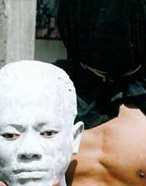 |
||
|---|---|---|
| CP Foundation | About CP Biennale | 2003 | 2005 | Contact Us | >||
           
|
||
|
Such symbolical representation can be seen in the sculpture being displayed in this biennale. The work, Drapheri (Drapery, 2003), mystically depicts death. Through the drapery or the folding of the clothes, Kustarto presents a brittle and perishable figure. As a model for the sculpture, Kustarto had drowned himself in darkness for the three hours of the casting process using polymer resin. This has brought him to a better understanding of death. Budi Kustarto wonders why humans often do not lead a more meaningful life before death arrives. Does death create in our subconscious some restlessness that finds its outlets in desperations, hedonism, crimes, aggressiveness, corruptions, egotism, or any other evil attitude? In another work, Mengikat (Tying Up, 2003), he presents again a depiction of his body, now busily tying up his poisoned feet. His head, meanwhile, is lying on the floor, dismembered from the body. Budi Kustarto believes that the decay in the sociopolitical life resembles a spreading poison able to destroy the body. The work is a symbolic representation of the effort to stop the decay, internally and socially. The ties, starting from the toes up to the knees, show the process through time to stop the decay before the poison gets to the center of our body, destroying our life. But still there are concerns whether it will all be futile, as depicted in the dismembered head. Budi Kustarto is known as a sculptor who takes advantages from realistic forms to convey allegorically the theme of pathos. He often creates the joints of his figurative sculptures using the techniques usually found in doll making. This is a symbolical representation of the capitalistic system that has created the existence of kitsch shops in our modern lifestyles. The human race has yielded to the greedy system and turned into a collection of data and objects. By using casting techniques with polymer resin and fiber, Budi Kustarto often portrays human figures that appear empty, troubled, and dusty. Such characters are further strengthened by the use of certain colors for the skin, which creates an impression of fragility. M. Agus Burhan Born on January 4, 1972 in Ajibarang, Central Java. SELECTED SOLO EXHIBITIONS SELECTED GROUP EXHIBITIONS |
||
|
CP Foundation | About CP Biennale | 2003 | 2005 | Contact Us
Jl. Suryopranoto 67A, Jakarta 10160, Indonesia. ph. +62.21.3448126, 3853206 | fax. +62.21.3853203, 3853208 info@cp-foundation.org |
||
 During his intense creative moments working as a sculptor, Budi Kustarto feels that he often faces incomprehensible matters, both in his personal life and in the wider social space. The problems settle in his mind, creating restlessness, feelings of conflicts, and psychological strains. All of them accumulate in his awareness about human's limited capability. Armed with such understanding, Kustarto begins to analyze the personal problems that his own body represents. Pain and death are corporeal symptoms that reflect the linkage with all life problems. Delving into the awareness about his own body, therefore, is identical with opening up the understanding about the body's linkage with complex socio-cultural dimensions. The body is the representation of reality. Kustarto positions his body as a symbolical reflection of the problematic reality. He intentionally uses his own body as the model for his works.
During his intense creative moments working as a sculptor, Budi Kustarto feels that he often faces incomprehensible matters, both in his personal life and in the wider social space. The problems settle in his mind, creating restlessness, feelings of conflicts, and psychological strains. All of them accumulate in his awareness about human's limited capability. Armed with such understanding, Kustarto begins to analyze the personal problems that his own body represents. Pain and death are corporeal symptoms that reflect the linkage with all life problems. Delving into the awareness about his own body, therefore, is identical with opening up the understanding about the body's linkage with complex socio-cultural dimensions. The body is the representation of reality. Kustarto positions his body as a symbolical reflection of the problematic reality. He intentionally uses his own body as the model for his works.